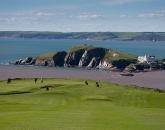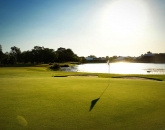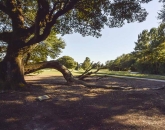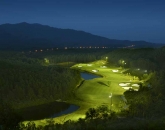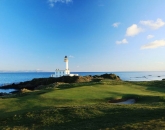Mother Nature’s role in the evolution of the Old Course at St. Andrews aside, the most important era in the history of golf course architecture was undoubtedly the first four decades of the twentieth century. Known within the industry simply as the Golden Age, the period was highlighted by the construction of a flood of courses that are now considered classic. It was during this time that the English heathland gems of Sunningdale and Wentworth were born. In Scotland, Gleneagles and Royal Dornoch came into existence. Across the Atlantic, Augusta National, Winged Foot, Cypress Point and Pine Valley—among many, many others—were laid out. Australia had Royal Melbourne and Kingston Heath, while South Africans enjoyed themselves on the links of Humewood and Durban Country Club. Even Argentina got in on the act with the establishment of two cracking layouts at the prestigious Jockey Club in Buenos Aires. Great courses, one and all.
But what of Asia? The common perception that golf is new to the Far East is understandable, but actually false. And while India and Sri Lanka boast the oldest courses at Royal Calcutta and Royal Colombo—which were inaugurated in 1829 and 1879 respectively—it is in Japan, at the courses designed by Charles Hugh Alison, where you’ll find Asia’s finest contribution to this groundbreaking age.
Alison’s story is an interesting one. Unlike his contemporaries—men like A.W. Tillinghast, Donald Ross, George Crump and Alister MacKenzie—his is not a name that many recreational golfers will be immediately familiar with. During his time as junior partner to the legendary Harry Colt, Alison collaborated on such noteworthy designs as the Seaside Course at Sea Island and the original eighteen holes at Long Island’s Timber Point. The unsung Englishman is even credited with helping to complete four remaining holes at New Jersey’s Pine Valley—generally regarded as the best course in the world—after Crump died in 1918. But it was in Japan, a country that few western architects of the era ever visited, that Alison really made his mark. During a six-month stay in the country, Alison designed four courses and helped redesign several more.
Noted for their small greens and vast, irregularly shaped bunkers (known in Japan simply as “Alison’s,” or “Arissons,” depending on the accent of the Japanese you speak to), Alison’s courses are the complete antithesis of the majority of courses built today; neither especially long or particularly reliant on water, the sweeping, well-protected fairways and subtle features of the greens complexes make them a true shot-makers delight.
The Philosophy
“Water is a bad feature in that the ball cannot be played from it, and in consequence it does not test the golfer’s skill. Its hideous charm lies in the fact that it is inexorable, and its landscape effect is often very valuable.” In regards to Japan he observed, “The Japanese love of ponds and lakes, and their exquisite skill in making them, is known throughout the world. Their love of water-hazards, were it not for their self-control, might develop dangerously.” C.H. Alison
TRIP PLANNER: The Alison Trail
Although it’s possible to book tee times and organize travel within Japan independently, given the language challenges and the fact that better clubs are strictly private, it’s easier to use a tour operator. Spring is the best time to go; it’s cherry blossom season and the temperatures are pleasant. Avoid Golden Week (2009: April 28 – May 5), a collection of four national holidays in just seven days, when hotels, trains and sightseeing spots are crammed with vacationing Japanese. Autumn is also ideal for golf: The turf is usually
at its best in September and October.
WHERE TO PLAY
Kawana Hotel Resort, Fuji Course
Japan’s answer to Pebble Beach, the Fuji Course is the most revered seaside track in the country and the only Alison-designed layout that doesn’t require a member’s introduction. Less than two hours from Tokyo, Kawana’s second eighteen—Oshima—is a shorter and more forgiving test in attractive parkland.
1459 Kawana, Ito-City, Shizuoka.
Architect: C. H. Alison, 1936.
Yardage: 6,691. Par: 72.
Greens Fees: $216-$277 (hotel guests only).
Contact : +81/557-451-111; www.princehotels.co.jp/kawana-e
Naruo Golf Club
A character-packed layout known for tiny well-bunkered greens, Nauro wouldn’t look out of place among England’s great heathland courses.
1-4 Kanegaya, Nishi-Uneno, Kawanishishi,
Ikeda, Hyogo.
Architects: H.C. Crane, 1920; C. H. Alison, 1931.
Yardage: 6,564. Par: 70.
Greens Fee: $137 (members’ guests only).
Contact: +81/727-941-011; www.naruogc.or.jp
Hirono Golf Club
One of the world’s great inland courses, Hirono could be the best kept secret in golf. Attractive ponds and Alison’s vast bunkers are hazards to avoid, but the elevated greens are a difficulty in themselves.
7-3 Shijimicho-Hirono, Miki-shi, Hyogo.
Architect: C. H. Alison, 1932.
Yardage: 7,169. Par: 72.
Greens Fee: $265 (members’ guests only).
Contact: +81/794-850-123.
TOUR OPERATORS
Japan Golf Tours (828-329-6000, japan-golf-tours.com) is the only golf tour operator catering specifically to non-Japanese speakers. It organizes two annual tours—during the spring and autumn—but can also tailor trips for groups of eight or more throughout the year. Its huge advantage is that it can also arrange golf at some of the country’s most prestigious clubs, including Hirono and Naruo. Another helpful website is golf-injapan.com, a good English-language resource detailing all the courses in the country and their contact details.
POST GOLF
Sitting stark-naked in a hot tub full of strangers might not appeal to everyone, but the onsen experience is a must for those wanting to immerse themselves (literally) in one of the most ancient forms of Japanese culture. The Japanese believe that the mineralized water helps ward off any number of potential ills, but even if you’re not convinced, they’re still a wonderful, stress-relieving way to wind down after a round. All golf clubs have an onsen, and visitors are welcome to use them at no extra charge. The most important thing to remember is that you must shower fully before entering one. And, although onsens are segregated according to sex, don’t be too put off if you see any little old ladies flittering around in the locker room afterward. They’re just doing their job.
Click here to see the published article.












